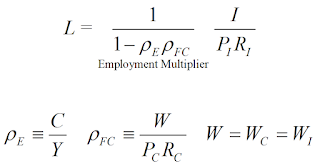Comment on Lars Syll on ‘Price rigidities and unemployment’
Blog-Reference and Blog-Reference
Orthodox employment theory is false because Orthodoxy as a whole is false because it is built upon microfoundations. In what has been called Keynesian Revolution, Keynes attempted the paradigm shift from microfoundations to macrofoundations. This attempt failed. Because Keynes got the formal foundations of macro wrong his employment theory, too, failed (2014).
The most elementary version of the axiomatically correct macroeconomic Employment Law (2012) is shown on Wikimedia AXEC62:
From this equation follows:
(i) An increase in the expenditure ratio ρE leads to higher employment L (the Greek letter rρ stands for ratio).
(ii) Increasing investment expenditures I exert a positive influence on employment, a slowdown of growth does the opposite.
(iii) An increase in the factor cost ratio ρF≡W/PR leads to higher employment.
The complete Employment Law is a bit longer and contains in addition profit distribution, public deficit spending, and import/export.
Items (i) and (ii) incorporate Keynes’s central message: “The basic explanation for unemployment is insufficient aggregate demand, and that is mostly determined outside the labour market.” (See intro)
This statement is half true. Insufficient aggregate demand is one half of the explanation of aggregate unemployment. The other half is about the relationship between wage rate and employment. And here it holds that Keynes got the working of the price mechanism wrong, just as Orthodoxy did.
What is missing in the Keynesian employment multiplier is the ratio rhoF as defined in (iii). This variable embodies the price mechanism. It works such that overall employment INCREASES if the average wage rate W INCREASES relative to average price P and productivity R. Vice versa, aggregate employment decreases with a decreasing average wage rate W.
This is EXACTLY what Keynes and anybody else could observe in one of the biggest unintended economic experiments ever: “During the depression money wages fell significantly and — as Keynes noted — unemployment still grew.” (See intro)
And this is the very OPPOSITE of what Orthodoxy has always taught and teaches to this day. Given the low-IQ level of economic discussions, the can has been kicked down the road with two side issues — flexibility/stickiness of wage rate/price and the vacuous semantics of voluntary/involuntary unemployment — until final inconclusiveness and confusion. This is NOT an accident but the natural mental state of both orthodox and heterodox economists — an equilibrium of stupidity, so to speak.
The explanation of unemployment consists of TWO elements: (a) insufficient aggregate demand, and (b), the fact that the price mechanism does NOT work as the representative economist hallucinates. Ultimately, though, unemployment is caused by the collective scientific incompetence of economists.
Egmont Kakarot-Handtke
References
Kakarot-Handtke, E. (2012). Keynes’ Employment Function and the Gratuitous Phillips Curve Disaster. SSRN Working Paper Series, 2130421: 1–19. URL
Kakarot-Handtke, E. (2014). The Truly General Theory of Employment: How Keynes Could Have Succeeded. SSRN Working Paper Series, 2406891: 1–25. URL
This blog connects to the AXEC Project which applies a superior method of economic analysis. The following comments have been posted on selected blogs as catalysts for the ongoing Paradigm Shift. The comments are brought together here for information. The full debates are directly accessible via the Blog-References. Scrap the lot and start again―that is what a Paradigm Shift is all about. Time to make economics a science.
